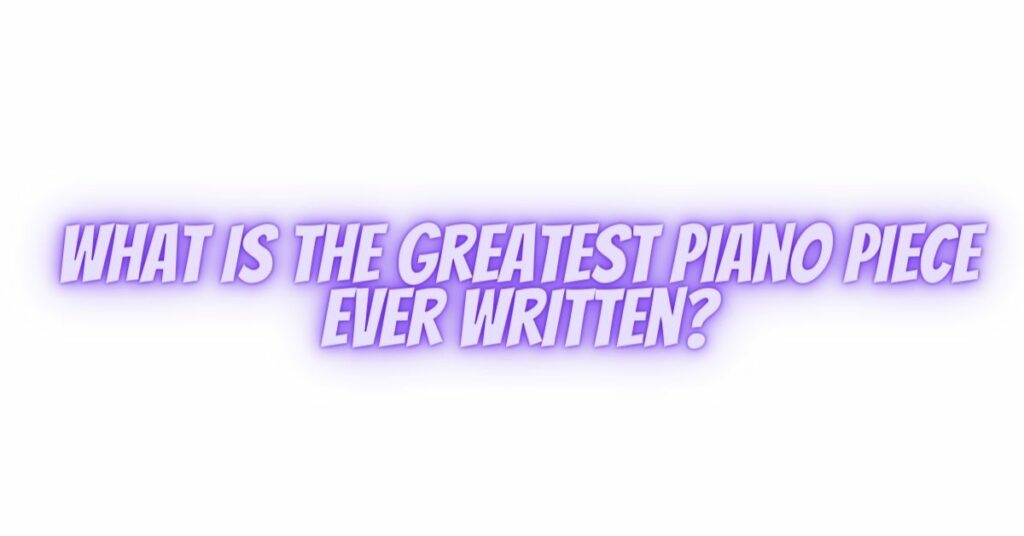The world of classical piano music is a vast, rich tapestry woven with compositions by masters like Beethoven, Chopin, Mozart, and countless others. The question of the greatest piano piece ever written is an elusive and subjective one, often sparking passionate debates among musicians and music enthusiasts. In this comprehensive article, we embark on an exploration of this ever-persistent question, acknowledging that greatness in music is as diverse and multifaceted as the compositions themselves.
The Challenge of Defining Greatness
The concept of greatness in music is elusive and inherently subjective. What makes a piano piece great varies from person to person, as it depends on individual taste, cultural background, and personal experiences. Some may prioritize emotional depth, while others may value technical complexity. The quest for the greatest piano piece is a never-ending journey.
Five Iconic Piano Pieces
While there isn’t a definitive answer to the question, we can certainly acknowledge several iconic piano compositions that are often regarded as some of the greatest ever written:
- Ludwig van Beethoven – “Moonlight Sonata” (Sonata No. 14, Op. 27, No. 2): Beethoven’s “Moonlight Sonata” is celebrated for its evocative and moody first movement. It’s a masterpiece of the Romantic era, filled with longing and introspection.
- Frédéric Chopin – “Nocturne in E-flat Major, Op. 9, No. 2”: Chopin’s Nocturne in E-flat is a prime example of his lyrical and emotional style. Its beauty and elegance have made it a beloved piece in the piano repertoire.
- Claude Debussy – “Clair de Lune”: “Clair de Lune” is a staple of impressionist music, celebrated for its dreamy and atmospheric quality. Debussy’s composition has the power to transport listeners to another world.
- Sergei Rachmaninoff – “Piano Concerto No. 2 in C Minor, Op. 18”: While this is a concerto, its breathtaking piano passages are worth mentioning. It’s known for its passionate melodies and technically demanding sections.
- Johann Sebastian Bach – “Goldberg Variations, BWV 988”: Bach’s “Goldberg Variations” is a masterpiece of counterpoint and ingenuity. Its complexity and depth make it a pinnacle of the Baroque era.
The Diverse Notions of Greatness
What makes a piano piece great is deeply personal and can encompass various aspects:
- Emotional Resonance: Some may consider a piece great if it elicits strong emotions or personal memories. Pieces like “Moonlight Sonata” and “Clair de Lune” excel in this regard.
- Technical Challenge: For many pianists and musicians, greatness is defined by the technical complexity and virtuosity required to perform a composition. Pieces like Rachmaninoff’s Second Piano Concerto exemplify this aspect.
- Innovation and Influence: Some pieces are celebrated for their innovative approaches, which set new standards or influenced the course of music history. Bach’s “Goldberg Variations” falls into this category.
- Timelessness: Great compositions have the ability to transcend time and remain relevant and captivating for generations. Chopin’s Nocturne and Debussy’s “Clair de Lune” are timeless in this regard.
Conclusion: Beauty in Diversity
The quest for the greatest piano piece ever written is a testament to the diversity of human experiences and the subjective nature of artistic appreciation. While certain compositions are universally acknowledged for their excellence, the true beauty of music lies in its ability to touch the soul in myriad ways. Whether you find greatness in the haunting melodies of Chopin, the emotional depth of Beethoven, the innovation of Bach, or the atmosphere of Debussy, the world of piano music is replete with awe-inspiring compositions that continue to captivate, inspire, and elevate the human spirit. The true essence of greatness in music is the kaleidoscope of emotions, memories, and experiences it evokes in each individual listener.


